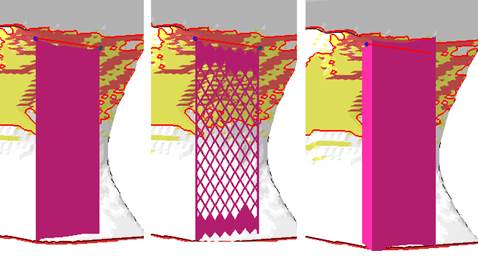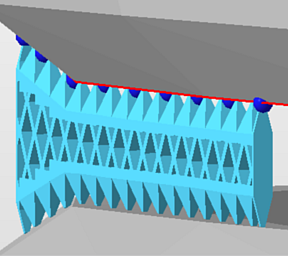Options and their function explained
Polyline supports are like fences. They are often used to complement volume support, or to trace sharp downward-facing edges that would otherwise go unsupported.
Jump to:
General parameters
| Polyline type |
Sets the type of polyline.  From left: Open wall, Patterned open wall, and Solid wall |
|
| Distance to part |
A stand-off distance between the end of supports and the part surface they connect with. Can be negative to sink support structure tips into the part if necessary. |
|
| Smoothing distance |
Determines how many steps will be used to smoothen a polyline. The smaller the distance, the stronger the smoothing and the more triangles will be used. |
|
| Smooth curves |
Switches the drawing of the resulting polyline supports through the placed anchors between discretely angled and continuously curved. |
|
| Line width |
Specifies the thickness of a solid wall. |
|
| Stand angle |
Support entities can be made conical with a wall angle of up to 45° from the vertical in either direction. To achieve the conicity, the angle is applied at the top, creating support that is either wider or narrower at the bottom. Note: This applies to each support element individually and can produce a self-intersections with neighboring clusters' supports that may need cleaning up.
|
|
| Rounded end |
Applies a radius to the ends of solid walls with thickness instead of leaving them square. |
|
| Structure properties |
Controls the hole pattern |
|
| Fragments |
Fragmentation creates gaps in normally continuous polyline support. Gaps make support easier to break off. |
|
| Connection | This group defines the connection between support, part, and platform ground. It is divided into multiple sub-groups. | |
| Projection |
Choose from three options to reshape the volume support to avoid or target other part surfaces (including no reshaping) using a hard knee shape or a smooth spline. |
Only available during editing of an already generated support entity |
Structure properties
| Structure pattern |
Set the type of the support structure |
|
| Width and Height |
Width and height of the hole shapes |
|
| Interval width and height |
Distance between neighboring holes to the sides and to those above and below. |
|
| Thickening up structure-hatches |
Values beyond 0 turn single-pass polylines without thickness into full meshes with volume. |
|
| Thickening up top connections |
If the structure is set to become thickened, a value can be set to specify the thickness of the top connections separately, allowing to create conical transitions between structure and part. |

|
| Thickening up bottom connections |
If the structure is set to become thickened, a value can be set to specify the thickness of the bottom connections separately, allowing to create conical transitions between structure and part. |
|
| Stitch tolerance |
Set a tolerance in millimeters up to which a gap between the structures is not going to be stitched. A value of 0.01 mm is recommended to keep as default. |
|
| Maximum height |
Polyline supports will be at most this long, measured from the downskin they originate on. If necessary, they will terminate in mid-air, not reaching the bottom plate. |
|
| Solid structure for height |
Configure polyline supports to have solid bases to improve strength for supports spanning greater Z distances. Applies the pattern along the vertical expanse only for this distance from the top connection and leaves the rest unpatterned. |
|
| Border width |
This overrides the width of the vertical fragment-lining strip as given by the connection properties value a in the illustration below. |
|
| Stringers |
Generates a single configurable stringer along the vertical centerline of a polyline or polyline fragment, strengthening the polyline with a backbone. |
|
| Keep distance to wall |
Addresses cases when an undercut would cause a support structure to come closer to a wall than the cluster's wall offset can provide for. |
|
| Use density map |
Applies information provided by a 3D heatmap to lighten or strengthen structures locally. |
|
 Minimum structure length
Minimum structure length
|
Any polyline or polyline fragment that would be generated with a length smaller than this value is not generated at all. |
|
 Fill incomplete bottom structure
Fill incomplete bottom structure
|
Fully fills bottom-most row of structure perforation if it's truncated by the bottom connection strip to make the strip stronger overall |
|
Stringers
| Generate stringers |
Toggles stringer generation |
|
| Width |
Width of the stringer
Note: If any fragment shrinkage is specified, the stringer width is scaled accordingly.
|
|
| Keep distance to support |
Detaches the stringer from the support by this distance |
|
| Top distance to part |
The stringer stops this distance short of terminating at the actual support's top end. |
|
| Bottom distance to part |
The stringer stops this distance short of terminating at the actual support's bottom end. |
Fragments
| Fragment contour |
Toggles contour fragmentation |
|
| Fragment contour length |
The polyline gets fragmented into segments at most this long. |
|
| Fragment contour gap |
Polyline fragments get spaced this far apart from each other. |
|
| Shrinkage width |
The bottom borders of fragments will be at most this long. Can be used to create W-shaped fragments as seen from the side. |
Connection
| Connection | |||
|---|---|---|---|
| Top part | Refers to supports terminating in part surface at its top end. | ||
| Bottom part | Refers to supports terminating in part surface at its bottom end. | ||
| Platform | Refers to supports terminating in the platform surface at its bottom end. | ||
| (Connection properties) | |||
| (Connection) |
Type of connection |
Select from: Strip, Trapoid, Breaking Points, Triangles.
|
|
| Connection width | a |
 Connection properties |
The width of the vertical strip on the far right can be overridden. See . |
| Connection height | b |
|
|
| Pin distance | c |
|
|
| Pins per structure | d |
|
|
| Distance connection to structure | e |
|
|
| Triangles on platform | Adds reinforcing triangle-shaped ribs to the platform connection, perpendicular to the polyline or contour. Not available when Angled Block Support is active. | ||
| Distance |
The interval between ribs |
||
| Width |
The width at the base of the ribs. The ribs are always equilateral triangles, so changing the width modifies the height accordingly. |
||
| Platform connection | This section defines the connection between support and platform ground. | ||
| Connection | Type of connection. See above for reference. | ||
| Hatches | Replicates the lower section of connections in parallel, up to 15 copies in each direction. This creates tapered, pedestal-like reinforcements. Accepts odd numbers up to 31 only, ignores even numbers. | ||
| Hatch distance | Distance between replications | ||
| Triangles on platform | Adds reinforcing triangle-shaped ribs or gussets to the platform connection, perpendicular to the polyline or contour. Not available when Angled Block Support is active. | ||
| Distance | The interval between struts | ||
| Width | The width at the base of the struts. The struts are always equilateral triangles, so changing the width modifies the height accordingly. | ||
